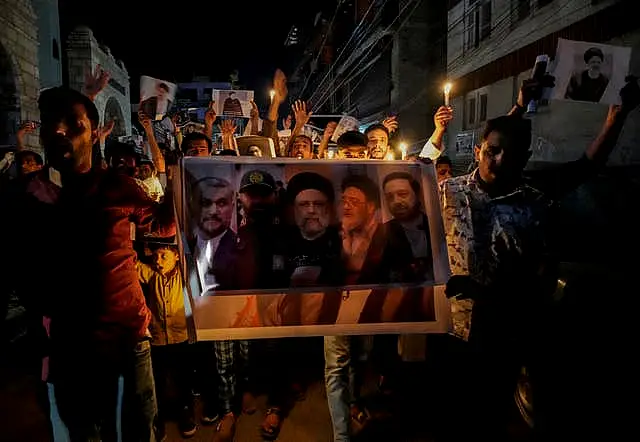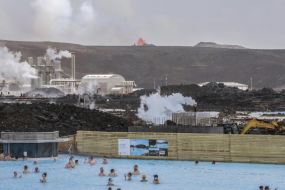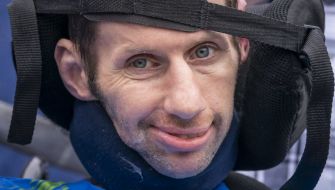Iranian president Ebrahim Raisi and the country’s foreign minister have been found dead hours after their helicopter crashed in fog, leaving the Islamic Republic without two key leaders as extraordinary tensions grip the wider Middle East.
Supreme Leader Ayatollah Ali Khamenei, who has the final say in the Shiite theocracy, quickly named a little-known vice president as caretaker and insisted the government was in control, but the deaths marked yet another blow to a country beset by pressures at home and abroad.
Iran has offered no cause for the crash nor suggested sabotage brought down the helicopter, which fell in mountainous terrain in a sudden, intense fog.
In Tehran, Iran’s capital, businesses were open and children attended school. However, there was a noticeable presence of both uniformed and plainclothes security forces.
Later in the day, hundreds of mourners crowded into downtown Vali-e-Asr square holding posters of Mr Raisi and waving Palestinian flags. Some men clutched prayer beads and were visibly crying. Women wearing black chadors gathered together holding photos of the dead leader.
“We were shocked that we lost such a character, a character that made Iran proud, and humiliated the enemies,” said Mohammad Beheshti, 36.
The crash comes as the Israel-Hamas war continues in the region. Iran-backed Hamas led the attack that started the conflict, and Hezbollah, also supported by Tehran, has fired rockets at Israel.
Last month, Iran launched its own unprecedented drone-and-missile attack on Israel.
A hardliner who formerly led the country’s judiciary, Mr Raisi, 63, was viewed as a protege of Mr Khamenei.

During his tenure, relations continued to deteriorate with the West as Iran enriched uranium closer than ever to weapons-grade levels and supplied bomb-carrying drones to Russia for its war in Ukraine.
His government has also faced years of mass protests over the ailing economy and women’s rights — making the moment that much more sensitive.
The crash killed all eight people aboard a Bell 212 helicopter that Iran purchased in the early 2000s, according to the state-run IRNA news agency.
Among the dead were Iranian foreign minister Hossein Amirabdollahian, the governor of Iran’s East Azerbaijan province, a senior cleric from Tabriz, a Revolutionary Guard official and three crew members, IRNA said.
Iran has flown Bell helicopters extensively since the shah’s era. But aircraft in Iran face a shortage of parts because of Western sanctions, and often fly without safety checks.
Against that backdrop, former Iranian foreign minister Mohammad Javad Zarif sought to blame the United States for the crash.
“One of the main culprits of yesterday’s tragedy is the United States, which … embargoed the sale of aircraft and aviation parts to Iran and does not allow the people of Iran to enjoy good aviation facilities,” Mr Zarif told The Associated Press.
Ali Vaez, Iran project director with the International Crisis Group, said that while US sanctions have deprived Iran of the ability to renew and repair its fleet for decades, “one can’t overlook human error and the weather’s role in this particular accident”.

Richard Aboulafia, an aerospace analyst and consultant, said Iran likely is tapping the black market for parts to maintain the fleet, but questioned whether Iran has the maintenance skills to keep older helicopters flying safely.
“Black-market parts and whatever local maintenance capabilities they’ve got — that’s not a good combination,” he said.
There are 15 Bell 212 helicopters with an average age of 35 years currently registered in Iran that could be in active use or in storage, according to aviation data firm Cirium.
State TV gave no immediate cause for the crash in Iran’s East Azerbaijan province. Footage released by IRNA showed the crash site, across a steep valley in a green mountain range.
US defence secretary Lloyd Austin said the US continues to monitor the situation surrounding the “very unfortunate helicopter crash” but has no insight into the cause.
“I don’t necessarily see any broader regional security impacts at this point in time,” he said.
For now, Mr Khamenei has named the first vice president, Mohammad Mokhber, as caretaker, in line with the constitution. The election for a successor was to be held on June 28, IRNA said.
Mr Raisi’s funeral was to take place in Mashhad, the city where he was born, on Thursday, with other funerals to be held on Tuesday, state TV said
Ali Bagheri Kani, a nuclear negotiator for Iran, will serve as the country’s acting foreign minister, state TV said.
Condolences poured in from neighbours and allies after Iran confirmed there were no survivors.
Indian Prime Minister Narendra Modi said in a post on the social media platform X that his country “stands with Iran in this time of sorrow”.
Russian President Vladimir Putin, in a statement released by the Kremlin, described Mr Raisi “as a true friend of Russia.”
Turkish President Recep Tayyip Erdogan, China’s Xi Jinping and Syrian President Bashar Assad also offered condolences.
Azerbaijan’s president, Ilham Aliyev, said he and his government were “deeply shocked.” Mr Raisi was returning from Iran’s border with Azerbaijan, where he had inaugurated a dam with Mr Aliyev, when the crash happened.
The death also stunned Iranians, and Mr Khamenei declared five days of public mourning. But many have been ground down by the collapse of the country’s rial currency and worries about regional conflicts spinning out of control with Israel or even with Pakistan, which Iran exchanged fire with this year.
Mr Khamenei stressed the business of Iran’s government would continue no matter what — but Mr Raisi’s death raised the spectre of what will happen after the 85-year-old supreme leader either resigns or dies.
Final say in all matters of state rest with his office and only two men have held the position since the 1979 Islamic Revolution.
Mr Raisi had been discussed as a contender. The only other person suggested has been Mr Khamenei’s 55-year-old son, Mojtaba.
However, concerns have been raised over the position going to a family member, particularly after the revolution overthrew the hereditary Pahlavi monarchy of the shah.
An emergency meeting of Iran’s Cabinet issued a statement pledging it would follow Mr Raisi’s path and that “with the help of God and the people, there will be no problem with management of the country”.
Mr Raisi won Iran’s 2021 presidential election, in a vote that saw the lowest turnout in the Islamic Republic’s history. He was sanctioned by the US in part over his involvement in the execution of thousands of political prisoners in 1988 at the end of the bloody Iran-Iraq war.
Under Mr Raisi, Iran now enriches uranium at nearly weapons-grade levels and hampers international inspections. Iran has armed Russia in its war on Ukraine, as well as launched a massive drone-and-missile attack on Israel amid its war against Hamas in the Gaza Strip.
It also has continued arming proxy groups in the Middle East, like Yemen’s Houthi rebels and Lebanon’s Hezbollah.







